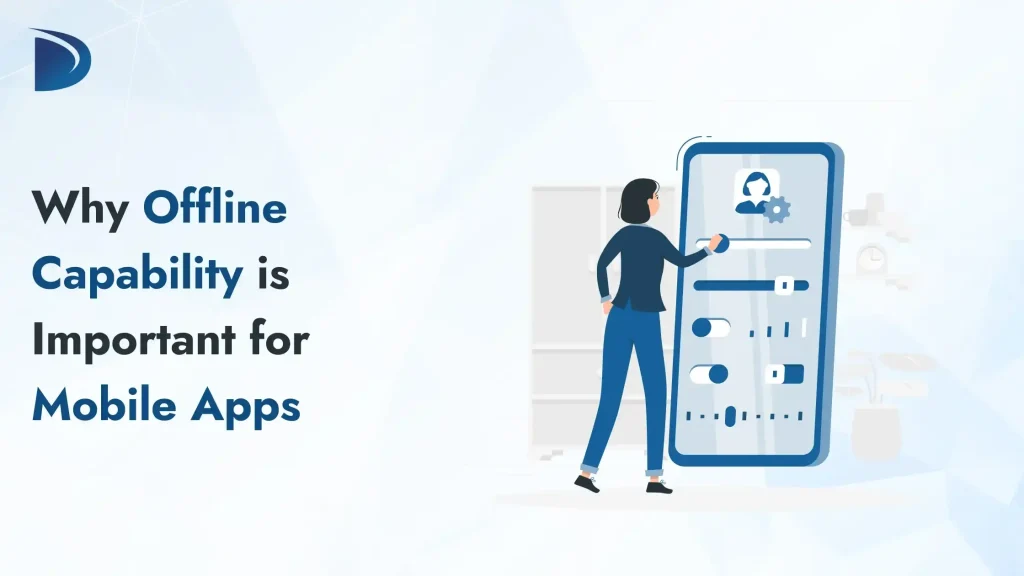Table of Contents
Let’s nip this one in the bud. Just because someone’s holding a phone doesn’t mean they’re connected. We like to believe we live in a world of uninterrupted access, where we scroll, swipe, stream, and sync on demand. The reality is that mobile apps still crash into dead zones, subway tunnels, and drop signals. Flights flip devices into aeroplane mode. Rural areas whisper “No Service” as if it were still 2012.
This is exactly why offline capabilities in mobile apps matter more than ever. Because a great app experience shouldn’t vanish the second the signal bar does. It should work with the user’s lifestyle, not against their bandwidth.
User Expectations: Instant, Seamless, Always-On
Users expect a seamless mobile experience. The days of tolerating loading screens, error messages, or sudden app crashes are now a thing of the past. Apps are now an integral part of daily life, and people expect them to work just like electricity: reliably and without requiring conscious effort.
When someone opens an app, they want it to respond immediately, continue from where they left off, and function even when the internet connection drops out. A weak signal in a parking garage or a flight with no Wi-Fi shouldn’t mean total downtime. To the user, it doesn’t matter why the app can’t connect, what matters is that it doesn’t work.
These expectations are driven by the experiences set by the best-performing apps on the market. Anything less feels outdated. If your app can’t keep up with this demand for speed and continuity, users will likely stick around. Offline capability meets users where they are, on the move, in and out of networks, and still expecting everything to work just fine.
Offline Capability as a Strategic Differentiator
A Better Mobile App Experience, Online or Not
Users don’t always have strong connectivity, and they shouldn’t need to use your app to access it. With built-in offline capability, your mobile app becomes more reliable, providing consistent access to critical features even in low- or no-network conditions. That kind of uninterrupted experience sets your product apart.
Reliability Builds User Retention
Frustration drives app abandonment. Offline-ready mobile apps reduce friction, improve session time, and strengthen trust. When users know they can rely on your app, they’re more likely to return, recommend, and stay loyal, directly impacting your user retention and engagement metrics.
Offline Support for High-Impact Use Cases
Industries like field services, healthcare, logistics, and education often operate in environments where internet access isn’t guaranteed. Mobile apps with offline support empower users to continue capturing data, viewing information, or completing tasks regardless of location, making your app a dependable tool, not just a convenience.
Standing Out in a Competitive App Market
Today’s app stores are flooded with alternatives. What gives your mobile app a performance edge? Features that respond to real-life challenges. Offline capability is a quiet but powerful differentiator. It boosts mobile app performance, elevates user satisfaction, and ensures your app performs when others fall short.
The Risks of Ignoring Offline Functionality
| Risk | Impact | Why It Matters |
| Poor User Experience | Users face blank screens, loading delays, or error messages when offline. | Without offline capability, your mobile app feels unreliable and frustrating to use. |
| Lower User Retention | Users abandon apps that don’t work consistently. | Lack of offline support leads to churn and reduces long-term user retention. |
| Limited Accessibility | Users abandon apps that don’t work consistently. | Ignoring offline features restricts reach, especially in remote, rural, or developing areas. |
| Missed Business Opportunities | Users in low-connectivity regions can’t access the app. | Industries that rely on app performance in real-world conditions need functionality anytime, anywhere. |
| Negative Reviews and App Ratings | Frustrated users leave poor reviews. | Field workers, healthcare staff, or delivery teams can’t complete tasks. |
| Competitive Disadvantage | Competing apps with offline support gain preference. | Users expect reliability. Apps that offer offline capability stand out in the market. |
How Offline Capability Works?
Local Storage: Keeping Data Within Reach
At the core of offline capability is local storage, saving key information directly on the user’s device. This allows the mobile app to load essential content, forms, and previously viewed data without needing an active connection.
Caching for Performance and Speed
Caching temporarily stores frequently used content to allow faster loading and better performance. This enhances the experience even when users go offline briefly, such as during travel or in areas with poor signal.
Background Sync: Seamless Data Updates
Once the device reconnects, background sync ensures that the data collected offline is updated automatically. This data synchronization enables users to work uninterrupted, while the system handles all syncing quietly in the background.
Conflict Management and Smart Sync Rules
Advanced, offline-ready mobile apps utilize intelligent logic to manage changes made both offline and online. If two users modify the same item, conflict resolution strategies prevent data errors. Some platforms even allow manual review to confirm updates.
Progressive Enhancement, Not Limited Functionality
Good offline design isn’t about stripping down the app; it’s about smartly deciding which features to support offline. Core tasks remain available, and enhancements load when online. This makes the app feel consistent and well-built, not limited.
Real-World Applications: Brands Leading the Offline UX Game
Google Maps – Navigation Without a Signal
Offline capability is essential to Google Maps. Users can download map areas, search locations, and get directions even when there’s no signal. It’s a perfect example of balancing usability and smart local storage to ensure uninterrupted value.
Spotify – Streaming in Aeroplane Mode
Spotify allows users to download playlists and podcasts for offline listening. This feature has enabled the app to dominate the audio streaming space, particularly for users commuting, traveling, or residing in remote areas.
Notion – Productivity On and Off the Grid
Notion’s offline-ready mobile app syncs changes once the connection returns. Users can take notes, update documents, and continue working smoothly without worrying about losing data, making it ideal for remote workers and creatives.
Microsoft Outlook – Email Access Without Internet
Outlook enables users to read, draft, and manage emails offline, syncing updates when reconnected. This offline functionality is essential for professionals who frequently travel or work in environments with variable connectivity.
Uber Driver App – Critical Functionality, Always Available
For Uber drivers, offline functionality is built into the app’s core. Even in poor signal areas, drivers can continue trips, navigate routes, and log activity, ensuring consistent service without dropping productivity.
Conclusion
Users expect apps to work at any time, anywhere. Offline capability is no longer a nice-to-have. It’s a key part of delivering seamless, reliable performance in app development.
If you’re ready to level up your mobile app development with true reliability, Differenz System is here to help. We build intelligent, offline-ready mobile solutions that not only meet user expectations but also exceed them.
FAQs
How does offline capability affect battery usage?
When designed properly, offline features can improve efficiency by reducing the need for constant server calls. However, poorly managed local storage or aggressive background sync can drain the battery. Optimization is key.
Can offline apps still collect analytics data?
Yes. Data can be stored locally and sent to analytics platforms once the device is back online. This ensures you don’t miss insights from offline usage periods.
How do I decide which features should work offline?
Focus on the core user journey. Prioritize functions that users rely on frequently, like viewing data, inputting forms, or using media. Optional or advanced features can be kept online only.
Will adding offline functionality increase development time?
Yes, slightly, but it’s an investment. Planning for offline use adds complexity, but the long-term payoff in user retention and performance often outweighs the initial effort.
Do app stores prioritize apps with offline features?
Not officially, but indirectly, yes. Higher engagement, better ratings, and fewer uninstalls due to poor connectivity can all lead to stronger rankings in app stores.

